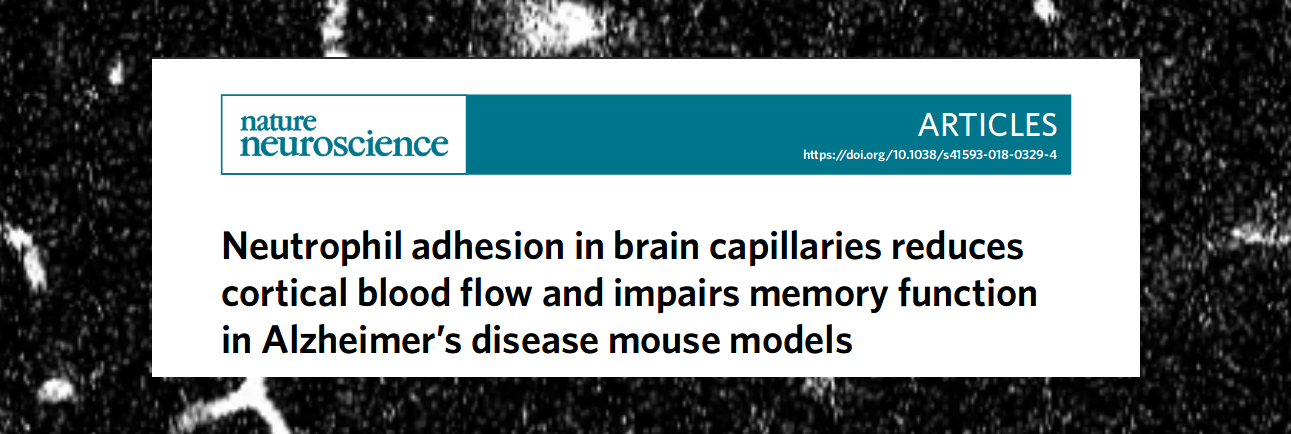The basis for everything we do in Stall Catchers was published in the article "Neutrophil adhesion in brain capillaries reduces cortical blood flow and impairs memory function in Alzheimer’s disease mouse models" by our collaborators at Cornell University in Nature Neuroscience today.
→ Read the full article HERE! ←
𝐁𝐑𝐄𝐀𝐊𝐈𝐍𝐆 𝐍𝐄𝐖𝐒 -- the basis for everything we do in #StallCatchers reported in @NatureNeuro today.
— EyesOnALZ (@eyesonalz) February 11, 2019
Article by our collaborators @SN_Lab: https://t.co/24f73XmYlu
The publication describes the amazing discoveries, which, for the first time in history, offered an explanation for the reduced blood flow in Alzheimer's brain: capillary stalls, and what causes them.
Neutrophils (a type of white blood cell) stick to the walls of the tiniest vessels of the brain at sites of inflammation, causing the "stalls" that we are looking for in Stall Catchers. Removing these neutrophils, i.e. removing the stalls, leads to improved memory & reduces other symptoms of the disease in mice.
But, as we already know, more questions need to be answered until we find therapies safe to use in humans. And and that's what we've been doing in Stall Catchers!
Will the next breaking news come from the Stall Catchers data?!
Let's make sure of it 😜 **Play the game that's speeding up the research --> [StallCatchers.com](http://StallCatchers.com)**Below is the "Discussion" part of the article, with translations to non-scientific :) :
In this study, we aimed to uncover the mechanisms contributing to reduced cCBF [cortical cerebral (outer layer of the brain) blood flow] in AD [Alzheimer's disease] and to determine the impact of this reduced cCBF on cognitive function. Brain blood flow reductions occur in the vast majority of dementia patients, including those with AD. These blood flow reductions are one of the earliest features of AD progression. Mouse models that express mutant APP [amyloid precursor protein -- i.e., have induced Alzheimer's disease] also show comparable reductions in CBF [cerebral (brain) blood flow].
Previous studies have implicated a variety of potential mechanisms in the CBF reductions seen in AD. Amyloid beta monomers [single amyloid beta protein molecules -- precursors to amyloid plaques] were found to drive vasoconstriction [constriction of blood vessels] in brain arterioles that could contribute to a reduction in resting CBF. In AD, there is a faster loss of vascular density [==number of vessels=] with age, which could reduce cerebral perfusion [brain blood flow]. In addition to decreases in baseline perfusion, the regulation of blood flow in the brain is compromised in AD. Vessel diameter changes in response to CO2 inhalation, blood pressure changes, and changes in local neural activity are all attenuated in AD patients and mouse models of APP overexpression [mice that have Alzheimer's disease]. This loss of dynamic regulation of cerebral blood flow could also contribute to cognitive impacts. Indeed, recent work showed that restoring cerebrovascular function, by angiotensin receptor inhibition [==this would reduce constriction of vessels=] or by reducing vascular oxidative stress [damage caused by free radicals] led to improved cognitive function.
Our data reveal that neutrophil [type of white blood cell, has a role in immunity] adhesion [sticking] to the capillary endothelium [tisue lining blood vessel walls] is a previously unrecognized mechanism for the flow reduction. The rapid resolution of the capillary stalls after α-Ly6G treatment [molecule that blocks neutrophil adhesion] suggests the stalls are caused by receptor-mediated interactions of neutrophils with the capillary endothelium, likely due to increased endothelial inflammation. Ly6G has long been appreciated as a neutrophil-specific marker [sticks to neutrophils and allows to label them for visualization in the lab]. Consistent with our findings, it has recently been shown that inhibiting Ly6G signaling leads to decreased migration of neutrophils toward sites of inflammation by modulating β2-integrin-dependent adhesion [doesn't stick to vessel walls as much].
Capillary obstructions due to tissue inflammation have been observed in a variety of organ systems (typically at higher incidence than observed here) and have been shown to contribute to the pathology and disease development. Inflammation is a persistent and well-recognized feature of AD and previous work has demonstrated an increase in inflammatory adhesion receptors [molecules on endothelial cell surface that stick with neutrophils and other cells, and present when there's an inflammation] on endothelial cells, which likely underlies the capillary stalling we observed. A significant contributor to this inflammation is increased reactive oxygen species (ROS) [free radicals causing damage to tissues] induced by brain exposure to Aβ oligomeric aggregates [amyloid plaques -- many amyloid beta protein molecules stuck together]. These ROS cause a loss of cerebrovascular flow regulation and likely drive the expression [the receptors start to be produced and present on cell surface] of leucocyte-binding receptors [receptors that bind to white blood cells] on the endothelial cell surface, such as ICAM1 and VCAM1. Our observation that some capillary segments were more likely to stall suggests that the underlying vascular inflammation [inflammation of blood cell that causes this] may not be uniform [not the same throughout the brain].
While here our focus has been on increased leukocyte adherence [sticking of white blood cells] causing a subset of capillaries to be transiently stalled [temporary clogged] due to a firmly adhered leukocyte, this increased leukocyte adherence likely also contributes to slowed, but not stalled, flow in other capillary segments when a leukocyte is present. Our experimental approach does not enable us to readily detect such slowed vessels. Our simulations included only the impact of completely stalled vessels, which may have contributed to the model’s underestimation of the increase in CBF after α-Ly6G administration [could be that the blood flow increased even more after treatment than could be measured]. However, the simulations predicted a similar sensitivity of brain blood flow to capillary stalling in humans and mice, suggesting that, if capillary stalling occurs in AD patients, significant blood flow improvements could be achieved.
We observed spatial and working memory improvements within 24 h of treatment with antibodies against Ly6G and LFA-1 [after treatments that reduce neutrophils] in multiple mouse models of Alzheimer’s disease [mice that have Alzheimer's disease, induced in different ways]. The temporal correlation between reduced capillary stalling/blood flow increase and the improvement in cognitive function suggests that a mismatch between neuronal energy metabolism and delivery of energy substrates through blood flow contributes to the cognitive deficit in these mouse models [the brain couldn't have restored its tissue so quickly, suggesting that cognitive symptoms in Alzheimer's could be caused not only by loss of tissue, but also because it is not getting enough nutrition through the blood stream, which can be reversed].
We also observed improved cognitive function after one month of treatment with α-Ly6G, which depletes neutrophils [treatment that reduces neutrophils], in APP/PS1 mice [mice that have Alzheimer's disease], measured during antibody therapy [while they were receiving treatment]. Because of the persistent depletion of neutrophils during this treatment, we expect that capillary stalling was reduced and brain blood flow increased throughout the month, including during cognitive testing, which probably contributed to the improved cognitive performance. In previous work by Zenaro et al. treatment with antibodies that deplete neutrophils (α -GR-1, α -LFA-1 and α -Ly6G) for one month in multiple Alzheimer’s disease mouse models (3xTg and 5xFAD) led remarkably to a persistent improvement in cognitive performance measured one month after the end of antibody therapy. This improvement was attributed to a decrease in the number of neutrophils present in the brain parenchyma [the functional tissue of the brain, responsible for the cognitive function], due to antibody-mediated depletion [reduction of neutrophils by antibody binding], and a resulting decrease in neuroinflammation [inflammation of brain neurons], and it is likely that this mechanism contributed to the improvement in cognitive performance we observed after one month of antibody therapy. Taken together, these studies show that neutrophil interactions in the vasculature and parenchyma of the brain [in both blood vessels and functional tissue of the brain] play a crucial role in the impaired cognitive function observed in multiple mouse models of amyloid-beta overexpression [mice that have Alzheimer's disease, induced by making them over-produce the amyloid beta protein].
Without a firm understanding of the underlying mechanisms that caused reduced CBF in AD, no medical approach to increasing brain blood flow has been developed or tested in humans. In a limited series of experiments in severe AD patients, a piece of omentum [part of membrane lining the abdominal cavity], which is known to secrete angiogenic factors [molecules than encourage blood vessel formation] and encourage new vessel growth, was surgically placed on the surface of the brain. In the patients that showed an increased CBF as a result, there were signs of improved cognitive function. Accordingly, improving CBF by interfering with neutrophil adhesion could be a promising therapeutic approach for AD [increasing blood brain flow by preventing neutrophils from sticking to blood vessels and stalling them could be a promising path towards an Alzheimer's treatment].
Find more human-readable science of Stall Catchers in our Science section here, and ask your questions on our forum here.


